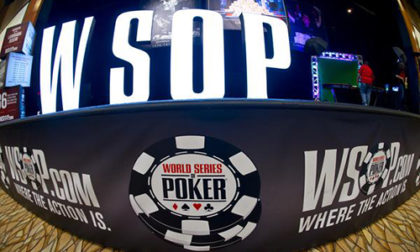Shot Clock, Big Blind Ante to be Tested at 2018 WSOP
The World Series of Poker typically releases rules changes a few weeks before the start of the annual poker festival, but last week, the poker community was given a sneak peak at a couple changes that will be tested out on a limited basis this summer. WSOP social media manager Kevin Mathers tweeted that the $1 million buy-in Big One for One Drop will use a shot clock and big blind antes; just a few minutes later, the official WSOP Twitter account added to that saying, the same will hold true for $50,000 and $100,000 buy-in events.
The reason for limiting the new features to just the super high roller-type events is likely ease of use. The World Series of Poker is an immense live tournament series with thousands of players packing the Rio for multiple tournaments every day. The shot clock, in particular, could be a disaster if something goes wrong with the technology or if the rules/implementation turn out to be confusing. The $50K, $100K, and Big One events will have relatively small fields, making new rules implementation much more manageable. Plus, most of the players in those tournaments will be very experienced, so they will have a better understanding of what is going on.
The goal of these additions is obviously to quicken the pace of play. Just like Major League Baseball has been tinkering with ways to shorten the duration of games, as there is a lot of downtime relative to actual baseball action, poker tournament organizers have been trying to cut down on excessive lulls for a while now. Shot clocks have been gaining more traction over the last couple years and in 2017, the World Poker Tour implemented the Action Clock, a shot clock that is used in the late stages of tournaments.
On the WPT, the Action Clock is put into play when the event is within one table of the money bubble. At that point, players have 30 seconds to act; if they fail to act in that time, their hand is folded or checked, depending on the situation. Players are also given time-extension chips, which can be surrendered if they need an additional 30 seconds to think things over. It seems that the Action Clock has been well received so far.
It is not known yet exactly how the shot clock will work at the World Series of Poker, whether it will be like the Action Clock and only used at certain points in the tournament or if it will be like online poker and used throughout the entire event.
The point of the shot clock is to limit a) stalling and b) excessive “tanking,” even in spots where a player rightfully needs to take a little more time to think. Nobody has a problem with someone taking 30 seconds or a minute or even a couple minutes sometimes to consider a very important hand, but there are players who “Hollywood” constantly, even on easy pre-flop decisions, or regularly take way too long on more difficult ones. These protracted delays suck the fun out of the game for the other players at the table. They can also be unfair, as the tanker’s tablemates may want more opportunities to chip up or, conversely, short stacks at faster moving tables will have a better chance of busting before the human rain delay.
In 2017, the WSOP implemented a rule change “designed to improve the pace of play and prevent habitual stalling.” The change tightened up the rules for calling the clock on a player. Rather than having to wait at least two minutes to call clock, players can do so whenever they feel it is justified. In addition, the countdown was reduced from a minute to anywhere from zero to 30 seconds.
The big blind ante will look a little odd to those who have never seen it before. In stages of the tournament where an ante is involved, the player in the big blind will pay the ante for everyone at the table. It may seem unfair at first and it will certainly stink for a short stack, but just as the big blind rotates around the table, so will the big blind ante. It will hit everyone.
Again, the goal here is to speed things up. Antes are simple, but players frequently forget to toss in that forced bet and have to be given a nudge. Or someone forgets to ante-up and at the same time has no idea that they forgot, so then time has to be wasted while everyone figures out who hasn’t made the pot right.
Perhaps the most extreme case of an ante causing a delay was at the 2006 WSOP Main Event. On Day 6 at the ESPN featured table, the dealer said someone had failed to put in their ante, pointing to the end of the table to her right. Jeffrey Lisandro said his chip was in and to his left, Dustin Holmes quietly tossed in an ante to get things on track. Prahlad Friedman, sitting to Holmes’ left, said he thought Holmes had put in his ante already. Holmes remained quiet and Lisandro indicated that Holmes had only put out his small blind.
For some reason, Friedman continued to question whether or not Holmes had already put in his ante, even as the play continued to the next hand. Holmes said nothing. Friedman said he wasn’t sure if he believed Lisandro that the ante was his and not Holmes’, which got Lisandro steamed. Lisandro said he wouldn’t effectively steal 5,000 chips from Holmes if he wasn’t positive that he (Lisandro) had already put in his ante, calling Friedman an idiot.
Lisandro was very offended that Prahlad said he may have “robbed” Holmes of chips and that he didn’t trust Lisandro; the two continued to argue as the dealer told them to drop it. When Friedman stepped away from the table to talk to a floor manager, Lisandro REALLY got mad, stepping to Friedman and telling him that he would “take your head off.”
As it turned out, Lisandro was correct. The missing ante was Holmes’.
So yeah, perhaps a big blind ante might save some headaches.



















COMMENTS